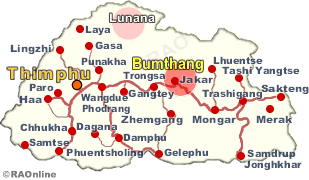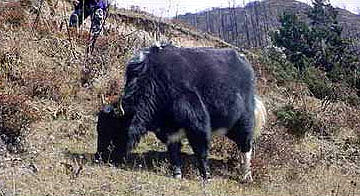 |
Bhutan's
Economy: Yak Farming |
 |
Bhutan Information |
|
 |
| Agriculture |
|
|
Bumthang:
A new role for the nomads
|
|
To secure the border by maintaining their territorial identity
|

|
 |
There was a time when nomads of Choekhor, Bumthang, trekked for five days with their yaks to a place called Choekong-la, a serene flatland bordering Tibet.
There they encountered nomads from across the border, who had travelled for a day with their yaks. While the herders pitched camps on their respective sides, their cattle coexisted and grazed in peace.
|
Not very far from the plains stood Bhutan's border outpost at Jagalung.
"There was also a stupa located near the outpost," Nangsiphel's village tshogpa Sonam Jamtsho recollects. But things started to turn sour, as Choekhor nomads began to notice their yaks disappearing.
"Nomads from the other side started taking advantage of having their homes nearer, and our herders returned with lesser number of yaks every year," the tshogpa said.
 |
Yak To save their yaks from being stolen, Choekhor nomads retracted and took their yaks up to the Pasamlung hot spring, about a four-day walk from Choekhor, in the following year. This also caused the outpost to shift near the hot spring site. "With hardly any yaks and herders to carry their supplies, they were left with no choice but to move," he said.
|
That was more than five years ago. Over time, those from across the border had constructed three permanent houses at the Choekongla grazing area
"Those herders were told the area until the Pasamlung hot spring belonged to them and that they would want to built houses there as well," Sonam Jamtsho said.
Taking note of the concern, agriculture minister Dr Pema Gyamtsho, during the recent nomad festival in Bumthang, said they were supporting the nomad communities through various initiatives but, in return, expected them to be responsible enough to help protect the border area.
"They should realise taking ownership of the area and maintaining the territorial identity is important for them," he said.
The minister said the government will support the nomads, in enhancing their livelihood through improvement of livestocks, pastures, cordycep cultivation and promoting eco-tourism, besides other development activities.
The agriculture ministry has also secured funds for a project dedicated to the entire nomad community in the country through the global environment facility.
"In the next few years, we'll do all we can to make it conducive for the highlanders to continue living in high altitudes," he said, adding at the same time, they should stop relying on the government and donors entirely.
Meanwhile, this season, while the Choekhor nomads are yet to decide whether to take their yaks up till the hot spring site, with the yaks disappearing even there, they worry there are too many consequences if they don't.
"While those at the border outpost might suffer without having anyone to transport their provisions, this can also encourage those from across the border to draw in closer," Sonam Jamtsho said. "After all, they're convinced the area till the hot spring belongs to them."
 |
| This article was contributed by Samten Yeshi, KUENSEL, Bhutan's National Newspaper,
2011 |
top
|
more
information
|

|

|
|
Yak
herding in the Haa Valley |
|





